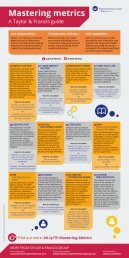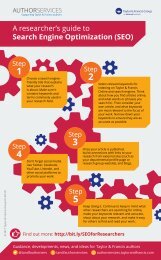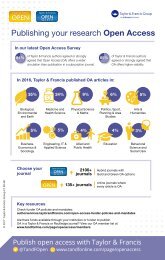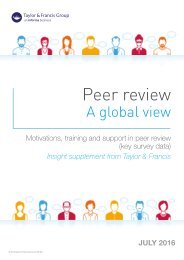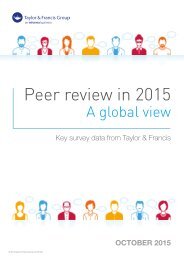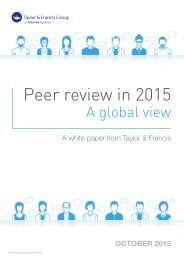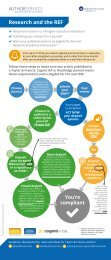Author_Services_Square_LR
You also want an ePaper? Increase the reach of your titles
YUMPU automatically turns print PDFs into web optimized ePapers that Google loves.
TIPS FOR PUBLISHING<br />
YOUR RESEARCH<br />
from <strong>Author</strong> <strong>Services</strong> at Taylor & Francis<br />
@tandfauthorserv<br />
tandfauthorservices<br />
authorservices.taylorandfrancis.com
AUTHOR SERVICES<br />
TIPS FOR PUBLISHING YOUR RESEARCH<br />
01-02<br />
WHY PUBLISH WITH TAYLOR & FRANCIS?<br />
We partner with researchers, scholarly<br />
societies, universities, and libraries<br />
worldwide to bring knowledge to life.<br />
As one of the world’s leading publishers<br />
of scholarly journals, books, e-books,<br />
and reference work, our content spans<br />
all areas of the Humanities, Social<br />
Sciences, Behavioral Sciences, Science,<br />
Technology and Medicine.<br />
We offer authors:<br />
Rigorous peer review for every journal article.<br />
High quality, rapid publication.<br />
The widest possible exposure through our global sales and<br />
marketing network, meaning your work has the reach you want it to.<br />
A choice of publishing options, whether you want to publish your<br />
article in a subscription journal or Open Access.<br />
Taylor & Francis Online: a state-of-the-art digital platform, offering<br />
high visibility and discoverability for every article.<br />
Partnerships with innovators, who work with us to improve<br />
the publishing experience for authors and make articles more<br />
discoverable (including Figshare, Kudos, ORCiD and Sciencescape).<br />
82%<br />
of authors would rate their<br />
likelihood of publishing with<br />
Taylor & Francis again as<br />
8 or above”*<br />
Taylor & Francis <strong>Author</strong> Survey, 2015<br />
CHOOSING<br />
A JOURNAL<br />
If in doubt, ask<br />
Some questions to think about when you’re choosing the right journal to<br />
publish your research in include:<br />
• Is the journal peer reviewed? What is its peer review policy?<br />
• Is it print, online or both? What’s my preference?<br />
• Is my research international? If so, does the journal have an<br />
international audience?<br />
• Who is the editor and who is on the editorial board?<br />
• Who publishes in the journal?<br />
• Who reads it?<br />
• What’s the journal’s Impact Factor?<br />
• Is it published by an international association or learned society?<br />
• Is the journal Open Access, or does it have an Open Access option?<br />
• What’s the submission process?<br />
Once you’ve chosen a journal, read the ‘Instructions for <strong>Author</strong>s’ carefully.<br />
Each journal has its own, specific set of detailed instructions, which can be<br />
found via a link on the journal’s web page.<br />
Still not sure if you’ve selected the right journal, or if your paper is<br />
right for it? Contact the editor who’ll be able to give you advice. You<br />
could even send them your abstract for feedback before submitting.<br />
Tips for authors at authorservices.taylorandfrancis.com<br />
@tandfauthorserv<br />
tandfauthorservices<br />
*on a scale of 1 to 10, 1 being the lowest, 10 the highest.<br />
More tips on choosing a journal at<br />
authorservices.taylorandfrancis.com/category/choosing-a-journal
AUTHOR SERVICES TIPS FOR PUBLISHING YOUR RESEARCH 03-04<br />
PREPARING YOUR PAPER<br />
Idea<br />
WHAT IS A<br />
JOURNAL<br />
ARTICLE?<br />
A journal article has a clear structure to its argument, references<br />
other literature, offers a concise overview of methods and findings,<br />
is accurately referenced, and often bound by a tight word count.<br />
Think about the structure of your paper. It should have:<br />
– Introduction: Offers a rationale for your paper and an overview to<br />
the specifics of the question.<br />
– Methods: Describes the method and procedures you used to<br />
reach your conclusions.<br />
– Results: Your findings should be described and commented on.<br />
– Discussion: What are the implications of your findings and<br />
their impact?<br />
Proof read<br />
& submit<br />
Choose a<br />
journal<br />
Check<br />
notes for<br />
contributors<br />
Writing your paper:<br />
the stages to go through<br />
Read the<br />
back issues<br />
WRITE<br />
FOR YOUR<br />
AUDIENCE<br />
Read the articles published in your chosen journal so you know who<br />
you’re writing for, the interests of the audience and the style of the<br />
journal. Plus, read and understand the journal’s aims and scope<br />
(on the individual journal page on Taylor & Francis Online), to make<br />
sure your research fits.<br />
Refine your<br />
drafts<br />
Write your<br />
first draft<br />
USE A<br />
CRITICAL<br />
FRIEND<br />
Let others read your drafts, so they can give you feedback on your<br />
paper and you can revise it before you submit it. A fresh pair of eyes<br />
can spot things you might have missed.<br />
Use acritical<br />
friend<br />
REACHING<br />
THE RIGHT<br />
AUDIENCE<br />
Search engine optimization is key to making your paper more<br />
discoverable. Start thinking now about these essential points, so you<br />
can get them right at this early stage.<br />
• Choose an effective title: be concise, accurate, and informative<br />
• Write an abstract that grabs people’s attention, and succinctly<br />
describes your article<br />
• Choose keywords carefully to maximize search returns<br />
• Use these in your title and abstract<br />
More tips on writing your paper at<br />
authorservices.taylorandfrancis.com/category/writing-your-paper
AUTHOR SERVICES TIPS FOR PUBLISHING YOUR RESEARCH 05-06<br />
READY TO SUBMIT YOUR ARTICLE?<br />
How to submit your article<br />
YOUR<br />
CHECKLIST<br />
Is your article clear, concise, and accessible?<br />
Have you stuck to the article length specified in the journal’s Instructions for <strong>Author</strong>s (on the<br />
individual journal page on Taylor & Francis Online)?<br />
Have you provided an informative and engaging abstract, highlighting your article’s key points?<br />
Have you included the name and affiliation of any/all co-authors?<br />
Is your article formatted to the style required by the journal?<br />
Are all references made to the literature included in your references section?<br />
Have you got written permission for the reproduction of any images/ figures/tables, etc.?<br />
PLUS:<br />
Remember you can only submit to one<br />
journal at a time, and your article cannot be<br />
previously published, or in press.<br />
Once you’re ready, the Instructions for<br />
<strong>Author</strong>s (on every journal’s webpage on<br />
Taylor & Francis Online) will guide you<br />
through how you should submit your article.<br />
The majority of Taylor & Francis journals use<br />
online submission systems, which enable<br />
journal editorial offices to manage the<br />
submission and peer review of articles.<br />
Find guidance on how to submit artwork in<br />
the right format in the journal’s Instructions<br />
for <strong>Author</strong>s (on each journal’s page on<br />
Taylor & Francis Online).<br />
Supplemental material can mean anything<br />
from tables to datasets, filesets to<br />
presentations, video to audio files. Including<br />
supplemental material with your article<br />
makes it more discoverable, and should be<br />
submitted at the same time as your article.<br />
If you have included tables, figures or<br />
images, check they are referred to in the text<br />
of your paper and that you have followed<br />
our guidance on using third-party material.<br />
Understand your rights as an author,<br />
your copyright options and the ethics of<br />
publication.<br />
authorservices.taylorandfrancis.com/ethicsfor-authors<br />
authorservices.taylorandfrancis.com/enhancingyour-article-with-supplemental-material<br />
authorservices.taylorandfrancis.com/usingthird-party-material-in-your-article<br />
authorservices.taylorandfrancis.com/copyrightand-you<br />
Check your chosen journal’s peer review policy (on the Instructions for <strong>Author</strong>s),<br />
as you may need to make your paper anonymous.<br />
And finally, don’t forget your cover letter.<br />
authorservices.taylorandfrancis.com/writing-acover-lettersubmission/coverletter.asp<br />
79%<br />
of authors would rate their overall<br />
satisfaction with their Taylor &<br />
Francis publishing experience as<br />
8 or above”*<br />
Taylor & Francis <strong>Author</strong> Survey, 2015<br />
*on a scale of 1 to 10, 1 being the lowest, 10 the highest.
AUTHOR SERVICES TIPS FOR PUBLISHING YOUR RESEARCH 07-08<br />
GETTING THROUGH PEER REVIEW<br />
Peer review allows your research to be evaluated and<br />
commented upon by independent experts who work within the<br />
same academic field. The peer review process can take different<br />
forms depending on the preference of the journal:<br />
Single-blind: the reviewer’s name is hidden from the author.<br />
Double-blind: the identity of the reviewers and the authors are<br />
hidden from each other.<br />
Open review: no identities are concealed.<br />
Post-publication review: comments can be made by readers<br />
and reviewers after the article has been published.<br />
THE PEER<br />
REVIEW<br />
PROCESS<br />
Editor receives<br />
manuscript<br />
Checks the article fits<br />
the journal's aims and<br />
scope<br />
What are the benefits of peer review?<br />
It helps to alert you to any errors or gaps in literature you may have<br />
overlooked.<br />
It helps to make the work more applicable to the journal’s<br />
readership.<br />
It can create discussion between the author, reviewers, and editor<br />
around a research field or topic.<br />
You can receive detailed and constructive feedback on your work<br />
from experts in the field.<br />
Reviewers are<br />
selected and receive<br />
the paper<br />
75%<br />
HOW LONG<br />
DOES PEER<br />
REVIEW<br />
TAKE?<br />
of authors rate their satisfaction<br />
with the refereeing process at<br />
Taylor & Francis as 8 or above”*<br />
Taylor & Francis <strong>Author</strong> Survey, 2015<br />
Most papers will be reviewed by two or more independent referees<br />
and ultimately by the editor(s) before a decision is made. The reviewers<br />
are active academics or professionals who may be receiving papers<br />
to be reviewed from a number of journals. Delays will inevitably occur<br />
when reviewers are busy, particularly if the journal has a high number of<br />
submissions. Our journal editorial teams endeavor to ensure that peer<br />
review is as timely as possible, but if you have a query on the progress of<br />
your paper please contact the editor.<br />
More tips on peer review at<br />
authorservices.taylorandfrancis.com/category/understanding-peer-review<br />
Article published<br />
Reviewers<br />
provide editor<br />
with comments,<br />
suggestions and a<br />
recommendation<br />
Proofing and<br />
production<br />
Amendments<br />
are made<br />
Comments and<br />
suggestions are<br />
reviewed by the<br />
editor and given<br />
to the author<br />
*on a scale of 1 to 10, 1 being<br />
the lowest, 10 the highest.
AUTHOR SERVICES TIPS FOR PUBLISHING YOUR RESEARCH 09-10<br />
PRODUCTION AND PUBLICATION<br />
Turning your paper into a published article is a crucial stage.<br />
Your research isn't registered until it is published. This is the stage for:<br />
Turning your paper into a journal article:<br />
the Version of Record<br />
CHECKING<br />
PROOFS<br />
COPY-<br />
EDITING<br />
An email from your Production Editor will alert you to the fact<br />
that your proofs are ready to check. Please check these carefully<br />
against the manuscript, approving or amending them. Once your<br />
corrections have been made to the article, it will be considered ready<br />
for publication. A second proof is not normally provided.<br />
As part of the production process, your article will be copy-edited to<br />
make sure that it conforms to the style of the journal and that there are<br />
no grammatical or spelling errors or inconsistencies which may affect<br />
a reader’s understanding of the article. The copy editor has a valuable<br />
role in picking up any errors that have been missed, minimizing delays,<br />
and ensuring problems are identified at an early stage.<br />
The ‘Version of Record’ is your final, published article hosted on Taylor & Francis<br />
Online and in the printed journal.<br />
By this stage, your article will have been through peer review, proofing, copyediting,<br />
and typesetting. Metadata will have been applied and deposited, it will<br />
have been mounted and hosted on Taylor & Francis Online (including enabled<br />
for mobile devices and tablets), we will have sent content to third parties, and<br />
it will have been disseminated to our global library and institution customers.<br />
<strong>Services</strong> such as Google Translate, CrossMark and, if appropriate, JournalMap<br />
or Sciencescape, will have been applied. Together these all support the<br />
discovery and preservation of your research.<br />
More tips on the production process at<br />
authorservices.taylorandfrancis.com/category/moving-through-production<br />
Get help with Taylor & Francis<br />
Editing <strong>Services</strong><br />
71%<br />
of authors rate their likelihood<br />
of recommending Taylor & Francis<br />
to a colleague as 8 or above”*<br />
Taylor & Francis <strong>Author</strong> Survey, 2015<br />
Make the process of preparing and submitting a manuscript easier with Taylor & Francis<br />
Editing <strong>Services</strong>, provided by Research <strong>Square</strong>. Offering English language editing,<br />
translation (from Chinese, Spanish, or Portuguese into English), manuscript formatting,<br />
and figure preparation, you can choose any one of these services or a combination.<br />
Find out more at<br />
www.tandfeditingservices.com<br />
*on a scale of 1 to 10, 1 being the lowest, 10 the highest.
AUTHOR SERVICES TIPS FOR PUBLISHING YOUR RESEARCH 11-12<br />
PROMOTING YOUR RESEARCH:<br />
HOW TO MAXIMIZE YOUR<br />
ARTICLE’S READERSHIP<br />
At Taylor & Francis, we are committed to increasing the visibility of every<br />
article published with us. As the author, you can also use your networks<br />
to promote your work to potential readers. Below are some quick and<br />
easy tips on ways to promote your research.<br />
UPDATE YOUR<br />
DEPARTMENT<br />
WEBSITE OR<br />
PERSONAL WEBPAGE<br />
ADD YOUR ARTICLE<br />
TO READING AND<br />
DISCUSSION LISTS<br />
Use your profile page on your department<br />
website, or your personal webpage, to add<br />
information about your article and link<br />
directly to it on Taylor & Francis Online.<br />
Add your article, or the journal, to your<br />
students’ reading lists, as essential reading.<br />
Plus, post a short message to any discussion<br />
lists you are a member of, letting people<br />
know that the journal’s latest issue, which<br />
includes your article, is now available.<br />
SHARE YOUR<br />
ARTICLE WITH<br />
YOUR 50 FREE<br />
EPRINTS<br />
USE SOCIAL<br />
MEDIA TO TALK<br />
ABOUT YOUR<br />
RESEARCH<br />
USE YOUR<br />
EMAIL TO TELL<br />
EVERYONE<br />
YOU’RE<br />
PUBLISHED<br />
Eprints are a link you can share which gives colleagues<br />
and friends free access to your article. Every named<br />
Taylor & Francis author (including co-authors)<br />
automatically receives 50 free eprints to share in any<br />
way you like – some authors put it at the bottom of their<br />
email signature, some email it direct to 50 people in their<br />
contacts list, and some post it on social media (e.g. Twitter<br />
or Facebook). Using your free eprint link directs people<br />
to your article on Taylor & Francis Online, enabling every<br />
download to be tracked, so you can see the impact of your<br />
work. <strong>Author</strong> feedback tells us this is a highly effective way of<br />
drawing attention to your research, with the link continuing<br />
to work even after 50 people have downloaded your article, by<br />
directing them to the article's abstract page.<br />
Many authors are increasingly promoting their articles via social<br />
media, posting a link to the published article so it can be picked up<br />
and shared by researchers and practitioners in their field. This can be<br />
on Twitter, Facebook, LinkedIn, or academic social networking sites<br />
such as Academia.edu, MyNetResearch and ResearchGate. Adding a<br />
link to the published article on Taylor & Francis Online also means you<br />
can see how many people are downloading your article, so you know<br />
how many people are reading it.<br />
You can quickly and easily use your email signature to let people know you’ve<br />
just been published, adding a line of text and a link to the article. We can<br />
also create a banner to put at the bottom of your emails – just visit the <strong>Author</strong><br />
<strong>Services</strong> website (authorservices.taylorandfrancis.com) and search for ‘Ensuring<br />
your research makes an impact’ for more information.<br />
UPDATE YOUR BLOG<br />
TALK TO YOUR<br />
UNIVERSITY PRESS<br />
OFFICE AND<br />
PUBLISHER<br />
MAKE A<br />
RECOMMENDATION<br />
TO YOUR LIBRARY<br />
28%<br />
If you blog, don’t forget to inform your<br />
readers about your article. You can post a<br />
quick summary and link to the article (and<br />
then spread the word via social media).<br />
If you think your article is newsworthy, talk<br />
to your university press office and let the<br />
marketing team at Taylor & Francis know.<br />
We’ve got a busy and active newsroom and<br />
will be able to help you publicize your work<br />
through our networks.<br />
Check that your institution has a subscription<br />
to the journal. If not, recommend it for the<br />
next subscription year.<br />
of authors plan to announce the<br />
publication of their article on<br />
social media, such as Facebook<br />
and Twitter.”<br />
Taylor & Francis <strong>Author</strong> Survey, 2015
AUTHOR SERVICES TIPS FOR PUBLISHING YOUR RESEARCH 13-14<br />
FIND OUT MORE ABOUT BOOK PUBLISHING<br />
AT TAYLOR & FRANCIS<br />
For two centuries Taylor & Francis has been fully committed to the publication of scholarly information of the<br />
highest quality, and today this remains the primary goal. Over the past two decades, the Taylor & Francis Group<br />
has grown rapidly and become a leading international academic publisher. Our books imprints in the humanities<br />
and social sciences include Routledge, Psychology Press, and Focal Press, while Garland Science and CRC<br />
Press publish in the life sciences and STEM fields. Our books span both established and emerging subjects<br />
across a variety of text types, ranging from research monographs (authored, multi-authored, and edited) to<br />
textbooks for all levels of students, professional books written by recognized experts, reference works, and<br />
handbooks. With global reach and offices in the U.S., U.K., and Asia-Pacific, we publish more than 3,500 new<br />
books each year, and have made over 55,000 eBooks available to individuals and institutions.<br />
Find out more at www.routledge.com/resources/authors<br />
PUBLISH<br />
OPEN ACCESS<br />
WITH TAYLOR<br />
& FRANCIS<br />
Taylor & Francis Open offers researchers the option to publish Open Access (OA) in a<br />
range of pure OA journals, whilst Open Select means you can publish OA in many of our<br />
subscription journals. Both offer:<br />
• A wide choice of journals to publish in, ranging across disciplines and subject areas<br />
• Rapid online publication<br />
• Rigorous peer review for every open access article<br />
• Immediate access to your article on publication, accessible by anyone, anywhere<br />
• High visibility and discoverability via Taylor & Francis Online<br />
• Global marketing and publicity, ensuring your article reaches the people you want it to<br />
• Download and citation statistics for your article, so you can measure its impact<br />
• Input from, and dialog with, expert editors and editorial boards<br />
• Retention of full copyright of your article through unrestrictive publishing agreements<br />
• Guaranteed legacy preservation of your article<br />
• Discounts and waivers for authors in developing regions<br />
Find out more at<br />
authorservices.taylorandfrancis.com/publishing-open-access-with-taylor-francis<br />
Helping authors in emerging regions<br />
Special Terms for <strong>Author</strong>s & Researchers (STAR) offers free online<br />
access for individual researchers from emerging regions, to support<br />
them in writing and becoming a published author. It is a Taylor &<br />
Francis initiative, undertaken in collaboration with our learned society,<br />
professional association, and co-publishing partners. It provides<br />
31 days FREE access to around 1,700 leading international and regional<br />
journals, simply by registering for a STAR voucher using the link below.<br />
More information visit<br />
authorservices.taylorandfrancis.com/supporting-authors-in-emerging-regions
About <strong>Author</strong> <strong>Services</strong><br />
Taylor & Francis <strong>Author</strong> <strong>Services</strong> offers guidance, developments, news and ideas for authors at all stages<br />
of the publishing process. Our website offers advice and tips on preparing your article and choosing a<br />
journal, plus information on what to expect during peer review, production, and once you’re published.<br />
Join us on Twitter (@tandfauthorserv) and Facebook (tandfauthorservices) for regular updates and<br />
insights on all things author-related.<br />
@tandfauthorserv<br />
tandfauthorservices<br />
authorservices.taylorandfrancis.com





